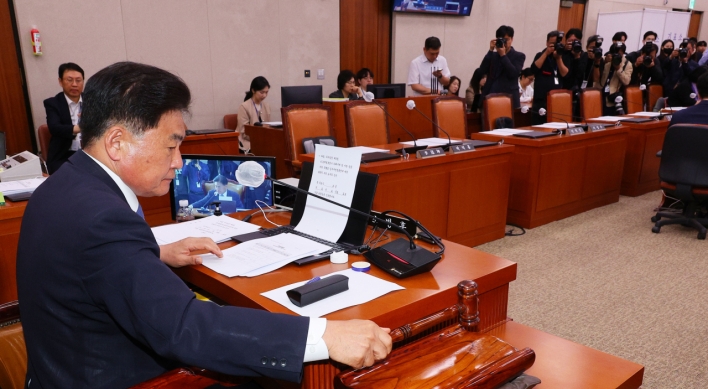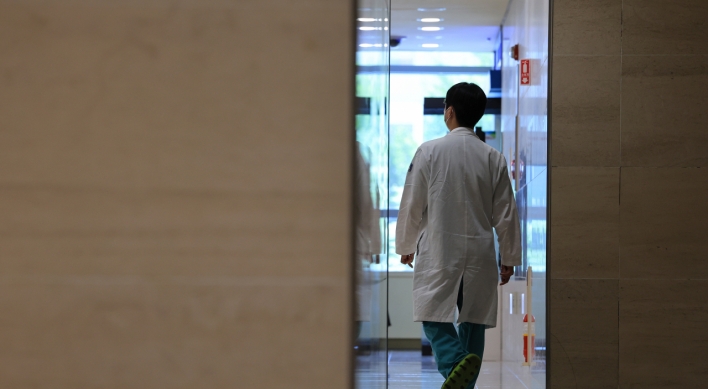The horrible damage caused by the massive earthquake that struck a wide area of eastern Japan on Friday has gradually become clear.
Coastal cities and towns in three prefectures in the Tohoku region ― Iwate, Miyagi and Fukushima ― have been devastated. Large tsunamis struck only minutes to several dozen minutes after the Tohoku Pacific Offshore Earthquake occurred, washing away houses and automobiles. The tsunamis even swept ships and boats inland.
Many fires also were reported. In Kesennuma, Miyagi Prefecture, the center of the city was almost completely destroyed. In Minami-Sanrikucho, about 10,000 of the town’s total 17,300 residents were missing.
In a shocking development, the cooling system for the No. 1 reactor at Tokyo Electric Power Co.’s Fukushima No. 1 nuclear power plant malfunctioned, causing an explosion that destroyed the outer wall of the reactor building. Many people must have felt shivers of terror as they watched the scene on TV news programs Saturday.
For safety reasons, reactors at nuclear power plants are part of a three-layer structure. The innermost part, the reactor, is inside a container, which is itself housed in a reactor building.
It was this outermost part, the reactor building, that was damaged in the explosion.
The explosion was believed to have been caused by gas that leaked from the container, but the container was unharmed and continues to serve its purpose, according to TEPCO.
However, the cooling system at the No. 1 reactor had not been functioning immediately after the great earthquake. The level of the cooling water decreased dramatically, exposing nuclear fuel rods and probably causing part of the fuel assembly to melt. It was the first serious nuclear incident in this country.
To deal with the situation, TEPCO decided to inject seawater into the reactor to completely cool it down. TEPCO had been reluctant to do so, because the salt and other substances in the water would made it difficult to operate the reactor in the future.
We believe this decision could have been made much earlier, given the importance of safety first.
Although the amount was small, radioactive substances were leaked outside the power station, heightening the general public’s fears of nuclear contamination. Residents around the power station were forced to evacuate their homes and put to great inconvenience.
We also question how the government has provided important information to citizens.
The explosion took place shortly after 3:30 p.m. Saturday, but Chief Cabinet Secretary Yukio Edano did not officially admit there had been an explosion until about two hours later at a press conference. His announcement that there had been no large leak of radioactive substances and that the explosion did not take place in the reactor container came more than five hours after the explosion.
Were these announcements too late? Edano did not mention any important information in his first news conference Saturday, such as the amount of radioactive substances released from the reactor or information about who should evacuate.
TEPCO and the Nuclear and Industrial Safety Agency of the Economy, Trade and Industry Ministry should closely cooperate to resolve the problems at the Fukushima No. 1 power plant’s No. 1 reactor.
Even if the scale of this earthquake was beyond the assumed maximum level in terms of quake resistance, lax crisis management should be severely questioned.
Nuclear power generation has become the fundamental source of energy in this country. However, the shock wave of the explosion may shake that position to its foundation.
The Three Mile Island nuclear accident in Pennsylvania in 1979 caused no significant radioactive contamination outside the facility. However, the partial core meltdown fueled public opinion against nuclear power generation in the United States. No power plants have been built in that nation since the accident.
The 1986 accident at the Chernobyl nuclear power plant in the former Soviet Union released large amounts of radioactive substances in that nation and others. More than 30 people were killed, many of them exposed to a considerable amount of radiation when extinguishing fires at the plant, for instance.
Many people developed thyroid cancer after the accident, which also fueled the anti-nuclear power movement, particularly in Europe.
The government must reinforce its system for preventing accidents at nuclear power plants. If the government makes mistakes in handling such accidents, the utilization of nuclear power stations at home and abroad will be jeopardized.
The number of people killed and missing has been increasing steadily. Many people are still stranded at school facilities, on the roofs of buildings or under debris waiting to be rescued.
Self-Defense Forces personnel, firefighters and police officers have already begun full-scale rescue and relief operations. Prime Minister Naoto Kan said he would mobilize many personnel from SDF garrisons all over the country. His administration announced the dispatch of 50,000 SDF members to quake- and tsunami-hit areas.
What evacuees want most is information about the safety of their families and friends. We would like police, as well as central and local authorities, to do their best to reunite people as soon as possible.
This is one of the most serious emergencies since World War II, and all the nation’s resources must be mobilized for disaster relief.
During talks with Kan, all opposition party leaders pledged again to fully cooperate with the government. They even proposed suspending the current Diet session and delaying some of the unified local elections scheduled for April.
What is most urgently needed is compilation of a large-scale supplementary budget to help quake-hit areas recover. The reserve fund for the fiscal 2010 budget only has about 200 billion yen left, not enough for sufficient recovery measures.
Both the ruling and opposition parties should compile a concrete proposal for the supplementary budget, including how to secure revenue. They should pass the budget at the Diet as soon as possible and then turn to implementing the measures.
(The Yomiuri Shimbun, March 13)
Coastal cities and towns in three prefectures in the Tohoku region ― Iwate, Miyagi and Fukushima ― have been devastated. Large tsunamis struck only minutes to several dozen minutes after the Tohoku Pacific Offshore Earthquake occurred, washing away houses and automobiles. The tsunamis even swept ships and boats inland.
Many fires also were reported. In Kesennuma, Miyagi Prefecture, the center of the city was almost completely destroyed. In Minami-Sanrikucho, about 10,000 of the town’s total 17,300 residents were missing.
In a shocking development, the cooling system for the No. 1 reactor at Tokyo Electric Power Co.’s Fukushima No. 1 nuclear power plant malfunctioned, causing an explosion that destroyed the outer wall of the reactor building. Many people must have felt shivers of terror as they watched the scene on TV news programs Saturday.
For safety reasons, reactors at nuclear power plants are part of a three-layer structure. The innermost part, the reactor, is inside a container, which is itself housed in a reactor building.
It was this outermost part, the reactor building, that was damaged in the explosion.
The explosion was believed to have been caused by gas that leaked from the container, but the container was unharmed and continues to serve its purpose, according to TEPCO.
However, the cooling system at the No. 1 reactor had not been functioning immediately after the great earthquake. The level of the cooling water decreased dramatically, exposing nuclear fuel rods and probably causing part of the fuel assembly to melt. It was the first serious nuclear incident in this country.
To deal with the situation, TEPCO decided to inject seawater into the reactor to completely cool it down. TEPCO had been reluctant to do so, because the salt and other substances in the water would made it difficult to operate the reactor in the future.
We believe this decision could have been made much earlier, given the importance of safety first.
Although the amount was small, radioactive substances were leaked outside the power station, heightening the general public’s fears of nuclear contamination. Residents around the power station were forced to evacuate their homes and put to great inconvenience.
We also question how the government has provided important information to citizens.
The explosion took place shortly after 3:30 p.m. Saturday, but Chief Cabinet Secretary Yukio Edano did not officially admit there had been an explosion until about two hours later at a press conference. His announcement that there had been no large leak of radioactive substances and that the explosion did not take place in the reactor container came more than five hours after the explosion.
Were these announcements too late? Edano did not mention any important information in his first news conference Saturday, such as the amount of radioactive substances released from the reactor or information about who should evacuate.
TEPCO and the Nuclear and Industrial Safety Agency of the Economy, Trade and Industry Ministry should closely cooperate to resolve the problems at the Fukushima No. 1 power plant’s No. 1 reactor.
Even if the scale of this earthquake was beyond the assumed maximum level in terms of quake resistance, lax crisis management should be severely questioned.
Nuclear power generation has become the fundamental source of energy in this country. However, the shock wave of the explosion may shake that position to its foundation.
The Three Mile Island nuclear accident in Pennsylvania in 1979 caused no significant radioactive contamination outside the facility. However, the partial core meltdown fueled public opinion against nuclear power generation in the United States. No power plants have been built in that nation since the accident.
The 1986 accident at the Chernobyl nuclear power plant in the former Soviet Union released large amounts of radioactive substances in that nation and others. More than 30 people were killed, many of them exposed to a considerable amount of radiation when extinguishing fires at the plant, for instance.
Many people developed thyroid cancer after the accident, which also fueled the anti-nuclear power movement, particularly in Europe.
The government must reinforce its system for preventing accidents at nuclear power plants. If the government makes mistakes in handling such accidents, the utilization of nuclear power stations at home and abroad will be jeopardized.
The number of people killed and missing has been increasing steadily. Many people are still stranded at school facilities, on the roofs of buildings or under debris waiting to be rescued.
Self-Defense Forces personnel, firefighters and police officers have already begun full-scale rescue and relief operations. Prime Minister Naoto Kan said he would mobilize many personnel from SDF garrisons all over the country. His administration announced the dispatch of 50,000 SDF members to quake- and tsunami-hit areas.
What evacuees want most is information about the safety of their families and friends. We would like police, as well as central and local authorities, to do their best to reunite people as soon as possible.
This is one of the most serious emergencies since World War II, and all the nation’s resources must be mobilized for disaster relief.
During talks with Kan, all opposition party leaders pledged again to fully cooperate with the government. They even proposed suspending the current Diet session and delaying some of the unified local elections scheduled for April.
What is most urgently needed is compilation of a large-scale supplementary budget to help quake-hit areas recover. The reserve fund for the fiscal 2010 budget only has about 200 billion yen left, not enough for sufficient recovery measures.
Both the ruling and opposition parties should compile a concrete proposal for the supplementary budget, including how to secure revenue. They should pass the budget at the Diet as soon as possible and then turn to implementing the measures.
(The Yomiuri Shimbun, March 13)










![[Kim Seong-kon] Democracy and the future of South Korea](http://res.heraldm.com/phpwas/restmb_idxmake.php?idx=644&simg=/content/image/2024/04/16/20240416050802_0.jpg&u=)








![[Today’s K-pop] Zico drops snippet of collaboration with Jennie](http://res.heraldm.com/phpwas/restmb_idxmake.php?idx=642&simg=/content/image/2024/04/18/20240418050702_0.jpg&u=)